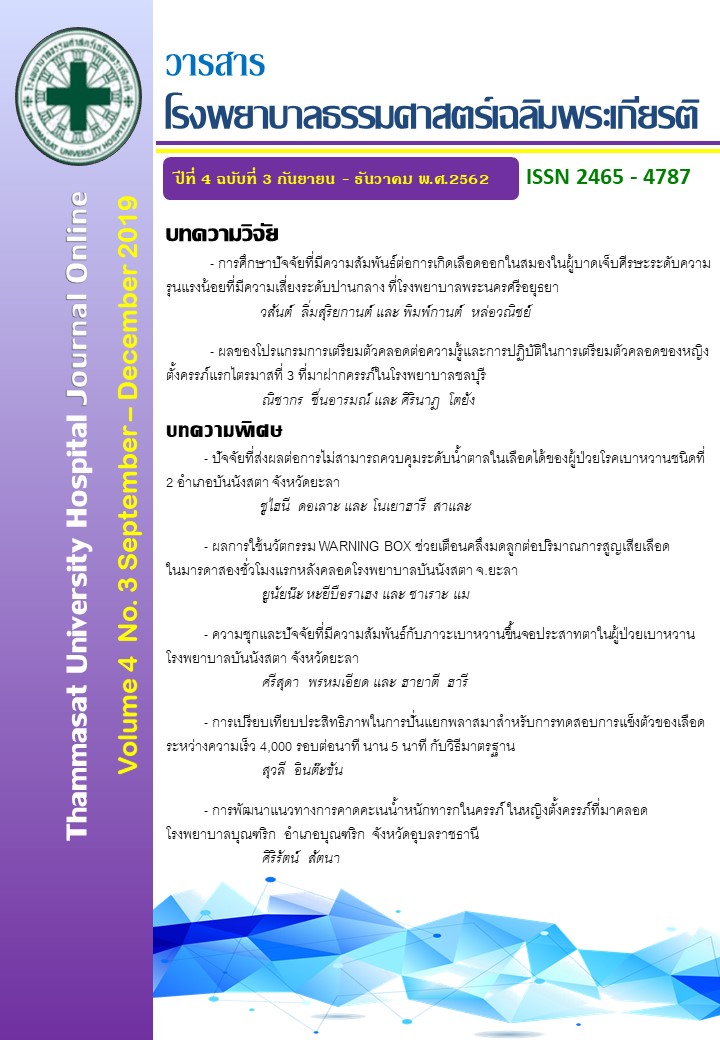การเปรียบเทียบประสิทธิภาพในการปั่นแยกพลาสมาสำหรับการทดสอบการแข็งตัวของเลือดระหว่างความเร็ว 4,000 รอบต่อนาที นาน 5 นาที กับวิธีมาตรฐาน
คำสำคัญ:
การทดสอบการแข็งตัวของเลือด, การปั่นแยกพลาสมา, การแตกของเม็ดเลือดแดงบทคัดย่อ
ความสำคัญของปัญหา: การตรวจวิเคราะห์ค่า Prothrombin time (PT), International normalized ratio (INR) และ Activated partial thromboplastin time (APTT) ในห้องปฏิบัติการใช้เป็นค่าการประเมินก่อนการรักษาด้วยยาละลายลิ่มเลือดในผู้ป่วยกลุ่มโรคหลอดเลือดสมองและหัวใจขาดเลือดเฉียบพลัน ซึ่งวิธีมาตรฐานในการปั่นแยกพลาสมาสำหรับการทดสอบการแข็งตัวของเลือดต้องใช้เวลาอย่างน้อย 15 นาที ทำให้ระยะเวลารอคอยผลการตรวจนานและเป็นอุปสรรคอย่างยิ่งต่อการช่วยชีวิตผู้ป่วย
วัตถุประสงค์: เพื่อเปรียบเทียบวิธีการปั่นแยกพลาสมาสำหรับการทดสอบการแข็งตัวของเลือดระหว่างความเร็วแบบใหม่ที่ 4,000 รอบต่อนาที นาน 5 นาที กับวิธีมาตรฐานที่ 1,500 g (3,500 รอบต่อนาที) นาน 15 นาที สำหรับนำมาใช้ในห้องปฏิบัติการเพื่อให้ได้ผลการตรวจ PT, INR, APTT ที่ถูกต้อง รวดเร็ว
วัสดุและวิธีการ: ศึกษาพลาสมาของผู้บริจาคโลหิตโรงพยาบาลสมุทรสาคร จำนวน 60 ราย เปรียบเทียบความแตกต่างของจำนวนเกล็ดเลือด (platelet count), ค่า PT, INR, APTT, potassium (K+) และ lactate dehydrogenase(LDH) ในพลาสมาที่ปั่นแยกด้วยความเร็วรอบ 3,500 รอบต่อนาที นาน 15 นาที และ 4,000 รอบต่อนาที นาน 5 นาที
ผลการศึกษา: จากตัวอย่างเลือดผู้บริจาคโลหิต 60 ราย พบว่า จำนวนเกล็ดเลือด, ค่า PT, INR, APTT, K+ และ LDH ไม่มีความแตกต่างกัน (p ≥ 0.05)
สรุป: การปั่นแยกพลาสมาด้วยความเร็วแบบใหม่ที่ 4,000 รอบต่อนาที นาน 5 นาที ไม่ทำให้เม็ดเลือดแดงแตกและค่าการทดสอบ PT, INR, APTT ไม่มีความแตกต่างกัน ดังนั้น หากนำวิธีการดังกล่าวไปใช้ในห้องปฏิบัติการจะสามารถรายงานผล PT, INR และ APTT ที่ถูกต้อง รวดเร็ว ทันต่อการรักษาผู้ป่วยในภาวะฉุกเฉินได้อย่างมีประสิทธิภาพ
เอกสารอ้างอิง
สถาบันประสาทวิทยา กรมการแพทย์. แนวทางการพยาบาลผู้ป่วยโรคหลอดเลือดสมอง สำหรับพยาบาลทั่วไป. พิมพ์ครั้งที่ 1. กรุงเทพฯ: ธนาเพรสการพิมพ์; 2559.
Clinical and Laboratory Standards Institute. Collection, Transport, and Processing of Blood Specimens for Testing Plasma-Based Coagulation Assays and Molecular Hemostasis Assays; Approved Guideline. 5th ed. CLSI Document H21–A5. Wayne, PA: Clinical and Laboratory Standards Institute; 2009.
พิสุทธินี กันธารักษ์, กนกวรรณ ใจพิงค์ และ สุรศักดิ์ เรือนกองเงิน. การศึกษาเวลาที่เหมาะสมในการปั่นแยกพลาสมาจากหลอด 3.2% Sodium Citrate เพื่อลดเวลาในการตรวจวิเคราะห์ PT, INR. [อินเทอร์เน็ต]. 2559 [เข้าถึงเมื่อ 2 ส.ค.2561]. เข้าถึงได้จาก: http: //www.zrolsoft.com/lpnhresearch/index.php/th/2559/39-3-2-sodium-citrate-pt-inr
Mansour MM, Azzazy HM, Kazmierczak SC. Correction factors for estimating potassium concentration in samples with in vitro hemolysis. Arch Pathol Lab Med 2009; 133:960-6.
Sweeney JD, Cheves TA, Laga AC. The effect of specimen hemolysis on coagulation test results. Am J Clin Pathol 2006; 126:748-55.
พัชราวดี ศรีงาม, จิราพร สิทธิถาวร, ภานุทรรศน์ กฤชเพชรรัตน์.การประเมินประสิทธิภาพการปั่นแยกพลาสม สำหรับการทดสอบการแข็งตัวของเลือดด้วยเครื่องปั่นเหวี่ยงความเร็วสูง. วารสารโลหิตวิทยาและเวชศาสตร์ บริการโลหิต 2556; 23:211-16
Chih HK, Ling CS, Wen HY. Evaluation of a high-speed centrifuge with rapid preparation of plasma for coagulation testing to improve turnaround time. J Biomed Lab Sci 2010; 22:23-7



